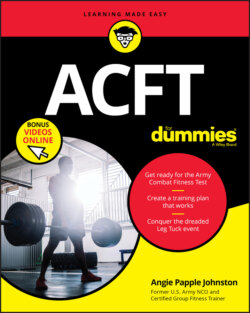Читать книгу ACFT For Dummies - Angela Papple Johnston - Страница 55
Having the Right Tools for the Job: Required Equipment
ОглавлениеLike everything else in the Army, you have to have the right tools for the job. In order to administer the ACFT, units must provide all the moving parts that make the test go.
The Army mandates that every battalion has one complete ACFT Equipment Set, which includes one or more
Bumper plates: Each lane must be equipped to accommodate soldiers lifting between 140 and 340 pounds of weight, and different lanes may have different weight configurations. The Army says additional 5-pound plates “may be acquired locally,” which means the unit can pirate them from the fitness center or another place that’s willing to share.
Sled with pull strap: Every lane requires one sled and pull strap. The sled has to be nylon and must be able to accommodate four 45-pound bumper plates. The pull strap must be 92 inches long and feature a handle on both ends.
10-pound medicine ball: The medicine ball must be approximately nine inches in diameter, made from hard rubber, and feature a textured grip surface. The Army says that the medicine ball must be weatherproof and that it has to be firm and nonmalleable.
40-pound kettlebells: Every lane needs two 40-pound kettlebells made from cast iron or cast steel, and they must have a closed, single-loop handle. Each kettlebell must be approximately 11 inches tall, have a flat base so it can stand with the handle positioned vertically, and be powder coated.
Metric measuring tape: Every lane needs a 30-meter-long, vinyl-coated fiberglass metric measuring tape. It must be in a shatter-resistant case with an “easy-to-wind, flush-folding handle.”
Climbing bars or a climbing pod: Many PT fields have climbing bars, but the Army requires units to use very specific setups. See Figure 3-2 for a look at the right climbing bar measurements. A portable pull-up bar is authorized if one of the climbing pods isn’t available, but it has to meet certain specifications. Whatever units use, they need one per lane.
© John Wiley & Sons, Inc.
FIGURE 3-2: Climbing pods for the ACFT.
The Army’s “Supplemental ACFT Supporting Equipment List” includes artificial turf strips (for the Sprint-Drag-Carry), field cones, measuring wheels, speaker boxes, pointers, outdoor clocks, and stopwatches, which units can use at their discretion.
The PT field you use matters, too. It needs to be soft, flat, and dry and must measure at least 30 meters by 50 meters — that’s a little less than half a football field. The ground has to be grass or artificial turf, and the site has to be free from significant hazards. Test administrators pick a site that has room to conduct the Preparation Drill and give briefings. The running course can be a track or any other solid, improved surface with less than a 3 percent uphill grade (with no overall decline). Figure 3-3 shows a 16-lane PT field setup.
© John Wiley & Sons, Inc.
FIGURE 3-3: Required ACFT field.
Every test site also needs an admin table that includes grade sheets, surveys, Form DD 2977 (Deliberate Risk Assessment Worksheet), Combat Lifesaver (CLS) bags (medical kits), and ice sheets. The admin table also serves as the CLS point where the medics hang out. Though every unit’s DD 2977 looks different, Figure 3-4 shows an example.
© John Wiley & Sons, Inc.
FIGURE 3-4: Sample DD 2977 for an ACFT.
